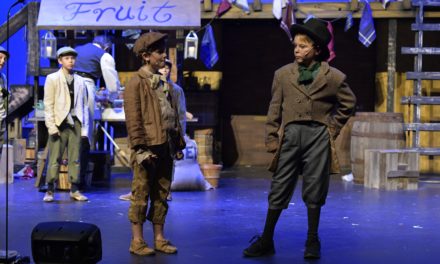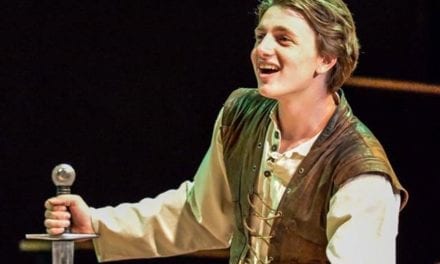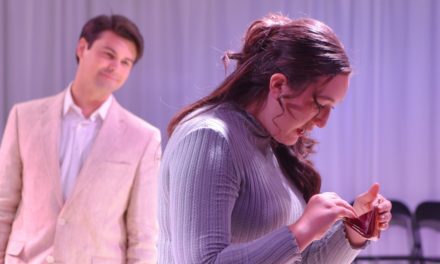GARDEN CITY — Being a teenager is a tough job. In high school, most of us wanted a lot of things: we wanted to belong, be liked, have friends, freedom, and we really really wanted that one special guy or girl to notice us. A lot of these desires don’t go away just because we grow up; everybody wants to be loved and accepted. In Hairspray, a musical set in the 1960s (with music by Marc Shaiman and lyrics by Shaiman and Scott Wittman), a teenager named Tracy Turnblad deals with these same challenges. She doesn’t fit in to the typical cool crowd, and she’s always getting into trouble at school. But she finds that by being herself she can still get what she wants out of life and help others do the same.
Tracy’s story is being brought to life this summer at the Pickleville Playhouse, and the lead role belongs to Kenzie Davis. Kenzie is a talented performer and I’ve seen her in several roles at Pickleville. But I was so pleased to see what she did with this character. Kenzie Davis’ Tracy has an innocent sweetness and a generous helping of soul. Her attitude toward inequality was matter-of-fact, optimistically determined. She gave me chills during tender moments and made me laugh with her gigantic personality. Pickleville’s duo of Tracy and Penny was perfect; I didn’t want to miss a moment when they were together. I can’t imagine a more quirky portrayal of Penny than the one Whitley O. Davis brings to the stage. She has a knack for comedy, and for making the audience laugh over and over.
Penny and Tracy each find a dreamy guy to call her own. Seaweed (Jeremy Egan) was the epitome of cool with his sideways smirk and killer dance skills. His devotion to the crazy Penny felt so genuine. Tracy’s crush is named Link (Christian Hobbs). He had the dreamy crooner part down pretty well. In fact, I felt that Tracy’s obsessive/stalker-ish behavior made total sense when Hobbs sang, “It Takes Two.” The chemistry of each couple had me swooning like a teenager.
Tracy’s parents, Edna and Wilbur, were played by two talented male actors, Kurt Haaker and Bryan Stephenson. And yes, if you’re new to Hairspray, Edna Turnblad is played by a man. Haaker delighted me as he played the concerned mother, the demure housewife, and then as his character fiercely protected her young. He’d throw in serious faces between smiles, and at choice moments his voice got low, like when Edna got riled up by Velma in the record shop, he told Tracy, “Hold Mommy’s waffles.” Stephenson played three characters in the show: he was Tracy’s dad, her principal, and the owner of a plus-sized dress store. Each of these three roles was individual and memorable; Stephenson shined in each one. (It was fitting that throughout the show, Haaker and Stephenson’s costumes got better and better.) “Timeless To Me,” a song and dance number between Tracy’s parents, made for a terrific scene. There was such a charming juxtaposition as this mismatched couple sang and danced together to Sharli King and Whitley O. Davis’s choreography. The whole scene was a perfect blend of affectionate and funny.
Another great choreography number was the mother/daughter duo, “Momma, I’m a Big Girl Now.” There were six women: Edna and Tracy, Prudy (Rachel Adams) and Penny, and Velma (Michelle Blake) and Amber (Tricia Zuskind). Each family pair was different from the other two, not only in physical appearance, but also in the way that they interacted. The acting was wonderful, but the choreography deserves the credit for keeping the scene from feeling repetitive. King and Whitley O. Davis used the whole stage to alternate the way the characters were grouped, and the actors glided through the scene.
There were a few times in the play when the choreography felt awkward. Once was in the all-around weird scene “Big Doll House,” where the female cast members peer out from behind prison bars in a random Chicago-esque way. Also uncomfortable was “Run and Tell That,” set in Miss Maybelle’s record store. The staging of that space felt forced; it looked so artificial when, for example, the characters formed a circle around one person. I felt, too, that if Blake had turned down her volume a bit in the record shop, it might have made the area seem larger.
The 60s era was brought to life through costuming and hairstyles. Andrea Davis filled the stage with color in the opening and closing numbers. Each character was detailed head to toe, with boys in shorter slacks and button-up cardigans, and girls in skirts and period wigs. I loved all the sparkles in the Miss Hairspray pageant. And the background lighting feature worked to enhance these visual elements. Velma has a pretty cool visual moment singing in a red dress in front of yellow and red glowing squares; her solo ends with the stage all in red around her dark silhouette thanks to Josh Roberts‘ lighting design.
Director Derek Davis was often difficult to hear as he played Corny Collins; he even had a period of time when his microphone didn’t work at all. And, sadly, “I Can Hear the Bells,” and “I Know Where I’ve Been,” had parts that seemed to be written too low for Kenzie Davis’s and Danielle Amour’s (Motormouth Maybelle) range. Overall, these two numbers were amazing, but I wondered if they could have been transposed a bit.
Pickleville’s production of Hairspray is touching and exciting; it contains themes we can all connect with. Kenzie Davis steals the show with her skills and sincerity; her softer version of “Baltimore” in the jail cell is a special moment. And Haaker is not to be missed, as he plays the fabulous Edna. Whether you’re a teenager or adult, confident or shy, everyone fits in at Pickleville. Just make sure to buy a ticket.




